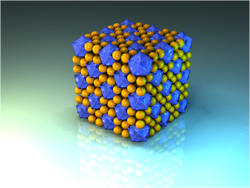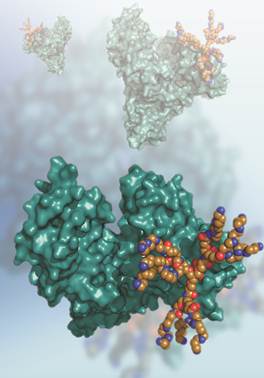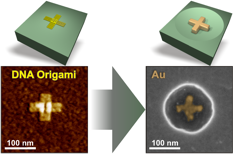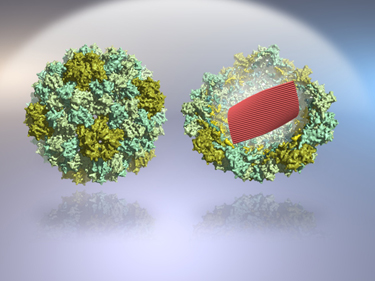Research
Synthetic and Biological Nanoparticles
Much of our research is focused on protein cages, such as virus capsids and ferritins. Virus particles – the old foes of mankind – can do much more than infect living organisms. Evolution has rendered them with the capability of highly controlled self-assembly properties, which can be utilized in new biohybrid materials. For example we have recently demonstrated that virus or magnetoferritin particles can self-assemble into binary superlattices with synthetic gold nanoparticles. The magnetoferritin assemblies can modulate efficiently spin–spin relaxation times of surrounding protons in water by enhancing the spin dephasing and consequently provide contrast enhancement in magnetic resonance imaging (MRI).

Binary nanoparticle superlattices are periodic nanostructures that are typically made from two different types of nanoparticles. This computer generated image shows a binary superlattice formed from cowpea chlorotic mottle virus (blue) and gold nanoparticles (yellow) that adopt a AB8fcc crystal structure – a structure that has not been observed before with nano-sized building blocks.
See also:
Nature Nanotechnology, 2013, 8, 52-56.
Nature Communications, 2014, 5, 4445.
ACS Nano, 2011, 5, 6394-6402.
Adv. Funct. Mater. 2011, 11, 2012-2019.
Dendrimers and Dendrons for Biomedical Applications
 Dendrimers and dendrons are periodically branched macromolecules with several remarkable properties, such as well-defined, monodisperse structure and ability to encapsulate functional materials. Dendrimers present multiple surface groups on the periphery allowing them to bind biomolecules with multivalent interactions and function as supramolecular glue for hierarchical assemblies. They were first described by Tomalia, Newkome, and Vögtle in the late 1970s and early 1980s. Amphiphilic Janus-dendrimers expand the scope by combining two distinct chemical functionalities in a single molecule and thus, can function as powerful structure-directing tectons for biomolecular complexes with greater versatility than regular dendrimers.
Dendrimers and dendrons are periodically branched macromolecules with several remarkable properties, such as well-defined, monodisperse structure and ability to encapsulate functional materials. Dendrimers present multiple surface groups on the periphery allowing them to bind biomolecules with multivalent interactions and function as supramolecular glue for hierarchical assemblies. They were first described by Tomalia, Newkome, and Vögtle in the late 1970s and early 1980s. Amphiphilic Janus-dendrimers expand the scope by combining two distinct chemical functionalities in a single molecule and thus, can function as powerful structure-directing tectons for biomolecular complexes with greater versatility than regular dendrimers.
We are especially interested in developping dendron-biomolecule conjugates. We have for example describe multivalent Newkome-type polyamine dendrons that function as synthetic DNA binding domains, which can be conjugated with proteins. These polyamine dendrons employ naturally occurring spermine surface groups to bind DNA with high affinity and are attached onto protein surfaces in a site-specific manner to yield well-defined one-to-one protein-polymer conjugates, where the number of dendrons and their attachment site on the protein surface are precisely known.
See also:
Nature Chemistry, 2010, 2, 394-399.
J. Am. Chem. Soc., 2014, 136, 6850-6853.
ACS Macro Letters, 2013, 2, 720-724.
J. Am. Chem. Soc., 2013, 135, 4660-4663.
DNA Origami Nanostructures
 DNA origami nanostructures are formed by folding a scaffold strand, i.e. a long single-stranded DNA (ssDNA), into desired shape with the help of a predefined set of oligonucleotides. The folding structures can be programmed into arbitrary two and three-dimensional shapes with nanometer scale precision, which opens up numerous attractive opportunities to engineer novel functional materials. All of the oligonucleotides in the designed structures are unique in sequence and readily available for modification. Therefore, a DNA origami can act as a versatile template for directing spatial arrangement of nanomaterials, e.g. metal nanoparticles.
DNA origami nanostructures are formed by folding a scaffold strand, i.e. a long single-stranded DNA (ssDNA), into desired shape with the help of a predefined set of oligonucleotides. The folding structures can be programmed into arbitrary two and three-dimensional shapes with nanometer scale precision, which opens up numerous attractive opportunities to engineer novel functional materials. All of the oligonucleotides in the designed structures are unique in sequence and readily available for modification. Therefore, a DNA origami can act as a versatile template for directing spatial arrangement of nanomaterials, e.g. metal nanoparticles.
We have recently utilized DNA origamis as confined enzyme cascade reactors, templates for the preparation of designer metal (plasmonic) nanostructures and tool for organizing silver nanoparticles into a bow-tie antenna configuration. We have also encapsulated DNA origami structures into virus particles to enhance their cellular delivery.
See also:
Trends in Biotechnology, 2015, 33, 586–594.
Nano Lett., 2014,14,2196-2200.
Chem. Comm., 2015, 51, 5351-5354.
Nanoscale, 2015, 7, 11267-11272.
Small, 2014, 10, 1057-1062.



